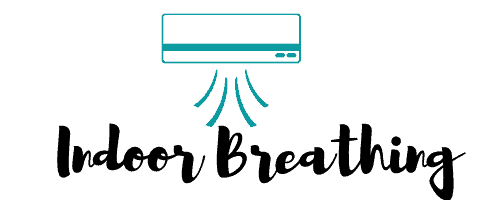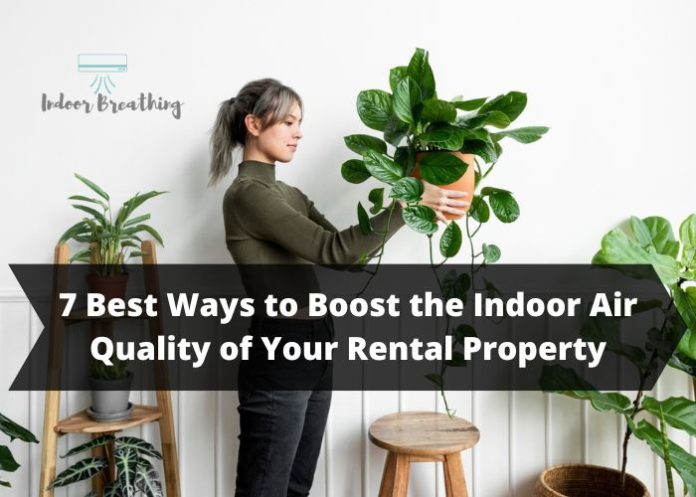As a landlord, it’s important to prioritize the health and comfort of your tenants. The indoor air quality is important for their well-being, as poor air circulation and pollution can result in respiratory problems and other health concerns.
Here are a few effective ways to enhance the overall air environment within your rental property, ultimately resulting in a more comfortable and healthy living experience for your tenants.
Table of Contents
Keep Your Property Clean
Regular cleaning can help remove dust, dirt, and other harmful particles from your rental property.
Regularly clean all surfaces, including floors, carpets, and upholstery, to promote a clean and healthy living environment.
Maintaining high indoor air quality (IAQ) in your rental property is crucial for the health and comfort of your tenants. Clean air can prevent respiratory problems, reduce allergens, and create a more inviting living environment. Here are seven effective ways to boost the indoor air quality of your rental property, emphasizing the importance of keeping your property clean.
Dust and dirt are primary contributors to poor indoor air quality. Regular cleaning and dusting can significantly reduce the presence of these pollutants. Focus on areas that tend to accumulate dust, such as:
- Carpets and rugs
- Upholstered furniture
- Curtains and blinds
- Baseboards and window sills
Encourage tenants to vacuum carpets and rugs frequently and consider investing in a vacuum cleaner with a HEPA filter to capture more fine particles.
Regular vacuuming and dusting can also help reduce the dust and dirt in your rental property. Using a HEPA filter can aid in capturing small particles to promote a healthier living space.
Good air quality can improve your tenants’ overall health and well-being, so it is a must-have for landlords and renters.
Control Moisture Levels
Excess moisture can lead to mold growth, harming your tenants’ health. Use a dehumidifier in damp areas, promptly fix leaks or water damage, and ensure proper ventilation to control moisture levels.
To prevent mold growth, it’s important to maintain a humidity level of 50% or less. Consider using a hygrometer to monitor the humidity levels in your rental property and take action if levels exceed them.
High humidity can lead to mold growth, which negatively impacts indoor air quality. Aim to keep indoor humidity levels between 30-50%. Use dehumidifiers in damp areas like basements and bathrooms. Ensure proper ventilation in these areas by installing exhaust fans and encouraging tenants to use them during and after showers.
Not only can excess moisture and mold growth negatively impact the health of your tenants, but it can also result in costly repairs and potential legal issues and complications.
As a responsible landlord, it’s important to prioritize moisture control and take preventative measures to ensure optimal indoor air quality and overall tenant satisfaction.

Use Natural Cleaning Products
Many cleaning products contain harsh chemicals that can release harmful fumes into the air. Opt for natural cleaning products like vinegar, baking soda, and essential oils to clean your rental property.
Many conventional cleaning products contain volatile organic compounds (VOCs) that can contribute to indoor air pollution. Opt for non-toxic, eco-friendly cleaning products to reduce the presence of harmful chemicals. These products are not only better for the environment but also safer for tenants, especially those with allergies or asthma.
Not only do natural cleaning products help to improve indoor air, but they are also better for the environment. This is because they typically contain biodegradable ingredients that do not contribute to pollution or harm wildlife.
Install Air Purifiers
If you rent luxury apartments, you want to provide your tenants with the best possible living experience.
Installing air purifiers in high-traffic areas, such as living rooms and bedrooms, can help eliminate harmful particles like dust, allergens, and pollutants from the air.
Air purifiers can be a valuable addition to any rental property. They help remove pollutants, allergens, and odors from the air, making it cleaner and fresher. Place air purifiers in commonly used areas like the living room and bedrooms. Ensure they are equipped with HEPA filters, which are effective at trapping small particles.
This will improve indoor environment quality and enhance your high-end rentals’ overall atmosphere and comfort level.
Test For Radon
Radon is a naturally occurring gas that can seep into homes and cause lung cancer. Test for radon in your rental property to ensure that your tenants are not exposed to harmful levels of this gas.
If high levels of radon are detected in your rental property, it’s important to take action to reduce exposure. This may include sealing cracks and gaps in the foundation or installing a radon mitigation system.
Radon is a colorless, odorless radioactive gas that naturally occurs from the breakdown of uranium in soil, rock, and water. It can seep into buildings through cracks and openings in the foundation. Prolonged exposure to high levels of radon can lead to lung cancer, making it imperative to test for and mitigate radon in rental properties.
Steps to Test for Radon:
- Purchase a Radon Test Kit: Available at hardware stores or online, these kits are easy to use and provide reliable results.
- Follow Instructions Carefully: Place the test kit in the lowest livable area of the property, away from windows, doors, and drafts. Leave it for the recommended duration (usually 2-7 days).
- Send the Kit to a Lab: After the testing period, send the kit to the specified lab for analysis.
- Review the Results: If radon levels are 4 pCi/L (picocuries per liter) or higher, take action to mitigate the radon.
Mitigation Methods:
- Increase Ventilation: Improve airflow in the property, particularly in the basement and ground floors.
- Seal Cracks: Seal cracks and openings in the foundation and walls to reduce radon entry.
- Install a Radon Mitigation System: Professional installation of a radon reduction system can effectively lower radon levels.

Use High-Quality Air Filters
Investing in high-quality air filters for your HVAC system is important to keep the air in your rental property clean and healthy.
Opt for filters with a high MERV rating, as they are better equipped to capture small particles and improve the overall quality of the air.
The first and most significant step in improving IAQ is to invest in high-quality air filters for your HVAC system. Air filters trap dust, pollen, pet dander, and other airborne particles, preventing them from circulating throughout the property. High-efficiency particulate air (HEPA) filters are particularly effective, capturing up to 99.97% of particles as small as 0.3 microns. Regularly replacing these filters ensures optimal performance and air quality.
Remember to change the filters regularly to ensure that they are functioning optimally. You should set reminders to change your filters every three months or more frequently if you have pets or rental property with high foot traffic.
Use Greenery
Greenery can naturally improve the air quality and make it cleaner. Encourage tenants to keep indoor plants in their rental units or place plants in common areas. This can add aesthetic value to your property while purifying the air.
The variety of sizes and shapes of plants available makes it easy to choose options that complement the style and decor of your rental.
Plants are also known to reduce noise pollution and create a more peaceful living environment.
Indoor air quality is a crucial aspect of maintaining a healthy and comfortable living environment, particularly in rental properties where tenants’ satisfaction is key. One effective and aesthetically pleasing way to enhance indoor air quality is through the use of greenery. Plants not only beautify spaces but also purify the air by absorbing toxins and releasing oxygen. Here are seven of the best ways to utilize greenery to boost the indoor air quality of your rental property.
1. Select Air-Purifying Plants
Certain plants are renowned for their air-purifying properties. Varieties such as spider plants, peace lilies, snake plants, and pothos are particularly effective at removing common indoor pollutants like formaldehyde, benzene, and trichloroethylene. Incorporating these plants into your rental property can significantly enhance air quality while adding a touch of nature to the space.
2. Strategically Place Plants in High-Traffic Areas
Placing plants in areas with the most foot traffic ensures that the benefits of air purification are maximized where they are needed most. Living rooms, kitchens, and entryways are ideal spots for larger plants, while smaller plants can be placed on shelves or tables in bedrooms and bathrooms. This strategic placement not only improves air quality but also creates a welcoming and vibrant atmosphere.
3. Create a Green Wall
A green wall, or vertical garden, is an innovative way to introduce a large number of plants into your property without taking up floor space. Green walls are particularly effective in urban settings where outdoor space is limited. These installations can be created using a variety of plants, including ferns, ivy, and succulents, which work together to filter the air and provide a stunning visual impact.
4. Use Planters with Air-Purifying Features
Some planters come equipped with integrated air-purifying technologies that enhance the natural benefits of the plants. These planters use activated carbon and other materials to trap pollutants, working in tandem with the plants to improve indoor air quality. Investing in such planters can provide an added layer of air purification, especially in areas prone to pollutants.
5. Incorporate Plants in Office Spaces
If your rental property includes a home office, incorporating plants into this space can be particularly beneficial. Studies have shown that plants can improve concentration, reduce stress, and increase productivity. Additionally, office equipment can emit pollutants, so having plants nearby can help mitigate these effects and create a healthier workspace.
6. Opt for Low-Maintenance Plants
For rental properties, it’s essential to choose plants that are easy to care for, ensuring that they remain healthy and effective at purifying the air. Succulents, ZZ plants, and snake plants require minimal watering and maintenance, making them ideal choices for tenants who may not have a green thumb. Providing care instructions and tips can also help tenants keep their plants thriving.
7. Regularly Rotate Plants
To keep your indoor garden thriving and your air quality at its best, consider rotating your plants regularly. This practice ensures that all plants receive adequate light and care, preventing any from becoming neglected. Regular rotation also allows you to inspect plants for signs of pests or disease, ensuring that your indoor greenery remains healthy and effective at purifying the air.
In Conclusion
Improving indoor air quality in your rental property is crucial for the health and well-being of your tenants.
Implementing these strategies to enhance indoor air quality in rental properties offers numerous benefits. Not only does it promote healthier living environments for tenants, but it also increases the property’s value and appeal. Regular maintenance of HVAC systems, the use of air purifiers, and proper ventilation are foundational steps. Incorporating indoor plants, choosing low-VOC materials, and maintaining a consistent cleaning routine further contribute to a cleaner, healthier indoor environment. Lastly, managing moisture effectively ensures that mold and mildew do not compromise air quality. By prioritizing these measures, landlords can provide a safe, comfortable, and attractive living space, ultimately leading to higher tenant satisfaction and retention.
By following these recommendations, you can create a comfortable and healthy living environment for your tenants and improve the value of your property in the process.


